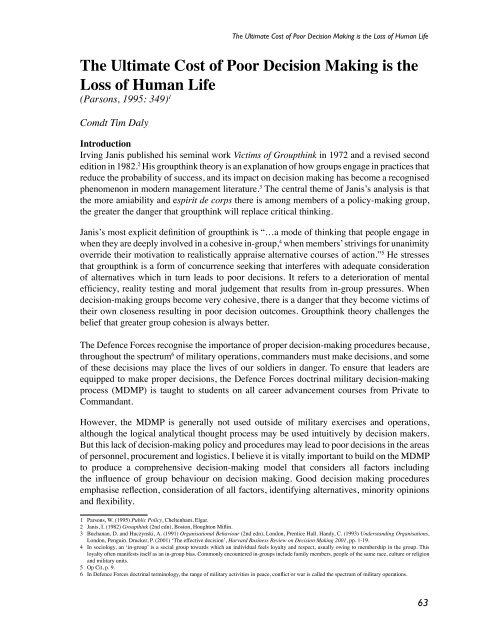Defence Forces Review 2010
Defence Forces Review 2010
Defence Forces Review 2010
You also want an ePaper? Increase the reach of your titles
YUMPU automatically turns print PDFs into web optimized ePapers that Google loves.
The Ultimate Cost of Poor Decision Making is the Loss of Human LifeThe Ultimate Cost of Poor Decision Making is theLoss of Human Life(Parsons, 1995: 349) 1Comdt Tim DalyIntroductionIrving Janis published his seminal work Victims of Groupthink in 1972 and a revised secondedition in 1982. 2 His groupthink theory is an explanation of how groups engage in practices thatreduce the probability of success, and its impact on decision making has become a recognisedphenomenon in modern management literature. 3 The central theme of Janis’s analysis is thatthe more amiability and espirit de corps there is among members of a policy-making group,the greater the danger that groupthink will replace critical thinking.Janis’s most explicit definition of groupthink is “…a mode of thinking that people engage inwhen they are deeply involved in a cohesive in-group, 4 when members’ strivings for unanimityoverride their motivation to realistically appraise alternative courses of action.” 5 He stressesthat groupthink is a form of concurrence seeking that interferes with adequate considerationof alternatives which in turn leads to poor decisions. It refers to a deterioration of mentalefficiency, reality testing and moral judgement that results from in-group pressures. Whendecision-making groups become very cohesive, there is a danger that they become victims oftheir own closeness resulting in poor decision outcomes. Groupthink theory challenges thebelief that greater group cohesion is always better.The <strong>Defence</strong> <strong>Forces</strong> recognise the importance of proper decision-making procedures because,throughout the spectrum 6 of military operations, commanders must make decisions, and someof these decisions may place the lives of our soldiers in danger. To ensure that leaders areequipped to make proper decisions, the <strong>Defence</strong> <strong>Forces</strong> doctrinal military decision-makingprocess (MDMP) is taught to students on all career advancement courses from Private toCommandant.However, the MDMP is generally not used outside of military exercises and operations,although the logical analytical thought process may be used intuitively by decision makers.But this lack of decision-making policy and procedures may lead to poor decisions in the areasof personnel, procurement and logistics. I believe it is vitally important to build on the MDMPto produce a comprehensive decision-making model that considers all factors includingthe influence of group behaviour on decision making. Good decision making proceduresemphasise reflection, consideration of all factors, identifying alternatives, minority opinionsand flexibility.1 Parsons, W. (1995) Public Policy, Cheltenham, Elgar.2 Janis, I. (1982) Groupthink (2nd edn), Boston, Houghton Miflin.3 Buchanan, D. and Huczynski, A. (1991) Organisational Behaviour (2nd edn), London, Prentice Hall. Handy, C. (1993) Understanding Organisations,London, Penguin. Drucker, P. (2001) ‘The effective decision’, Harvard Business <strong>Review</strong> on Decision Making 2001, pp. 1-19.4 In sociology, an ‘in-group’ is a social group towards which an individual feels loyalty and respect, usually owing to membership in the group. Thisloyalty often manifests itself as an in-group bias. Commonly encountered in-groups include family members, people of the same race, culture or religionand military units.5 Op Cit, p. 9.6 In <strong>Defence</strong> <strong>Forces</strong> doctrinal terminology, the range of military activities in peace, conflict or war is called the spectrum of military operations.63
















